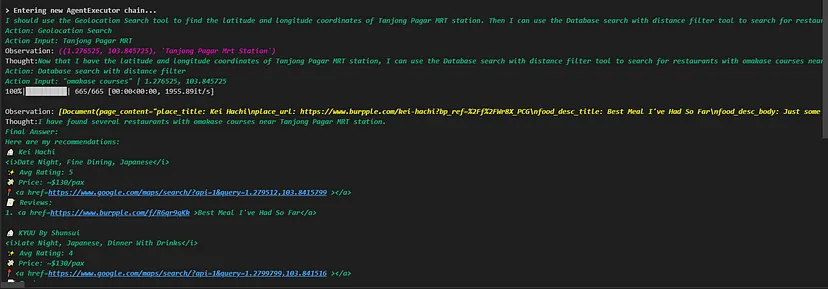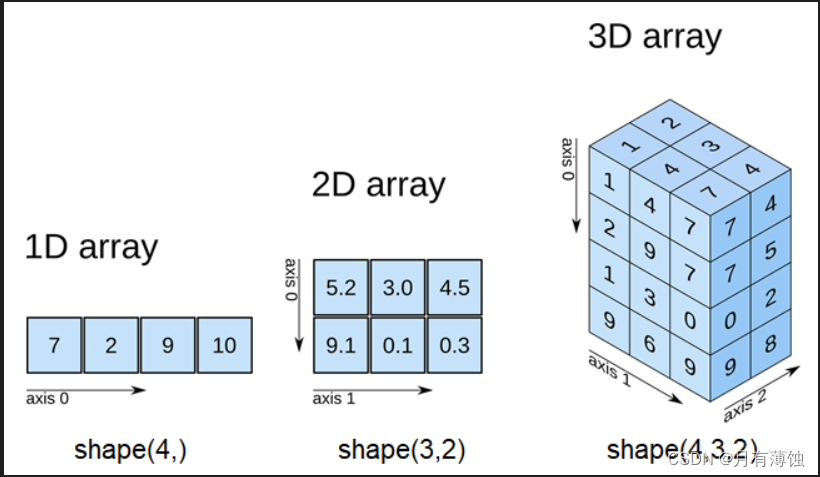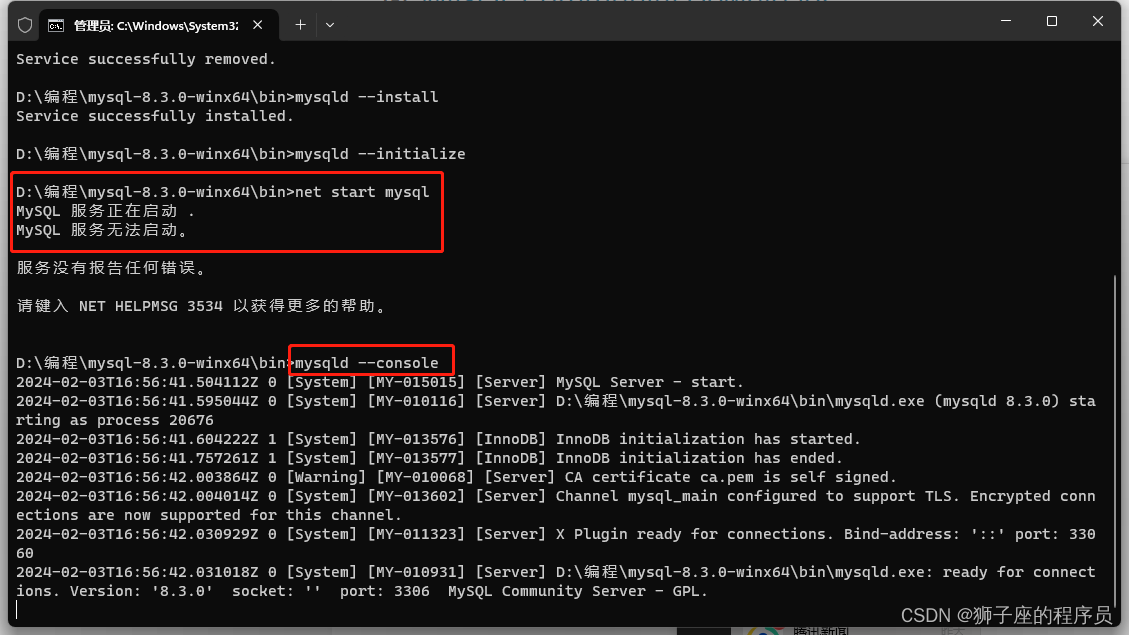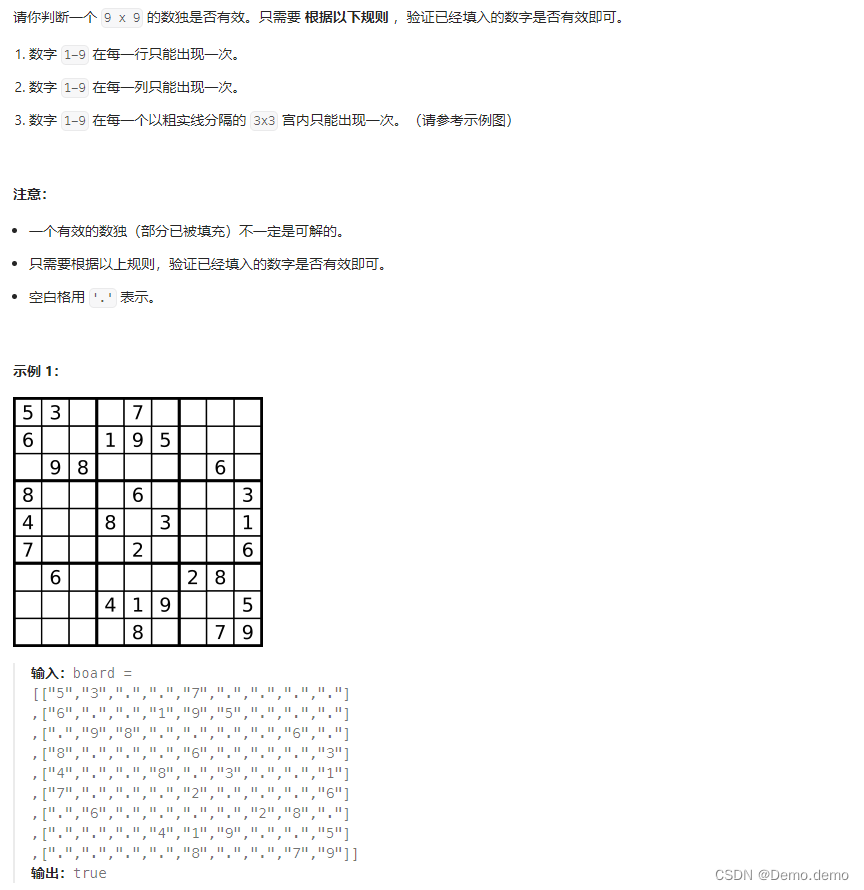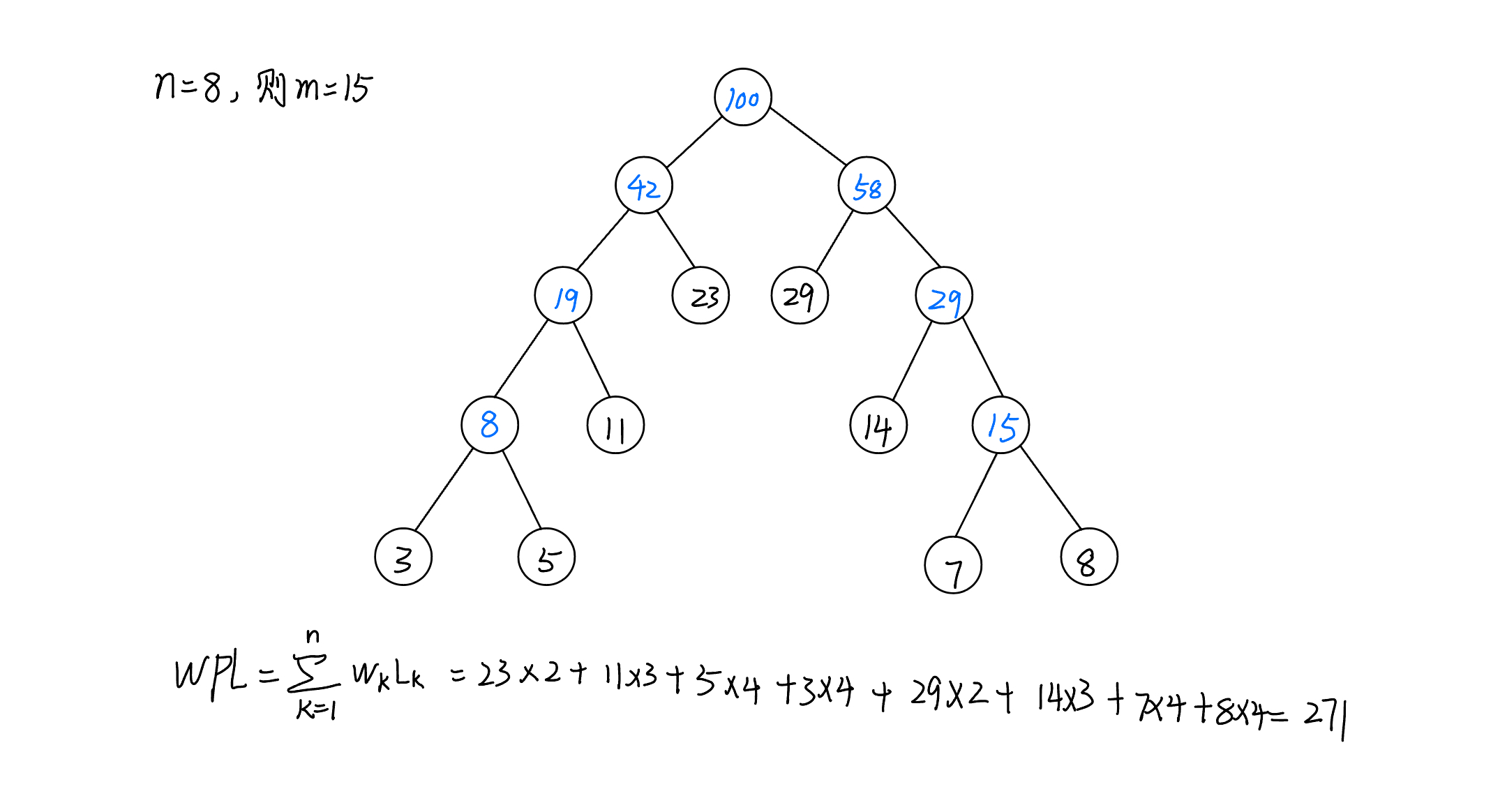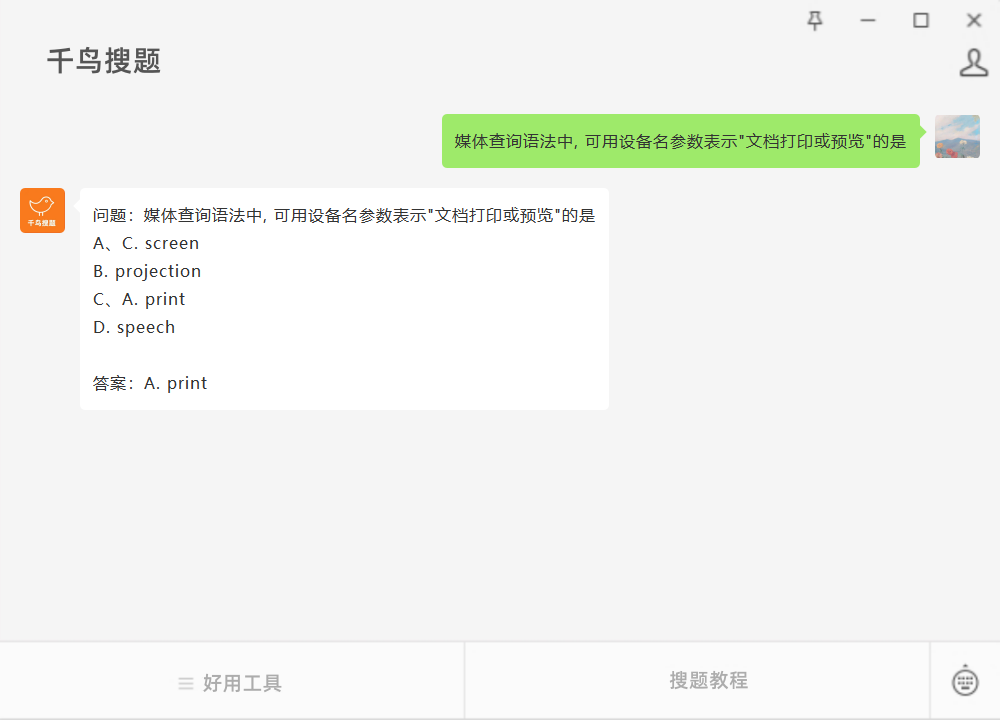KNN-k近邻算法
k-Nearest Neighbors
- 思想极度简单
- 应用数学只是少
- 效果好
- 可以解释机器学习算法使用过程中的很多细节问题
- 更完整的刻画机器学习应用的流程
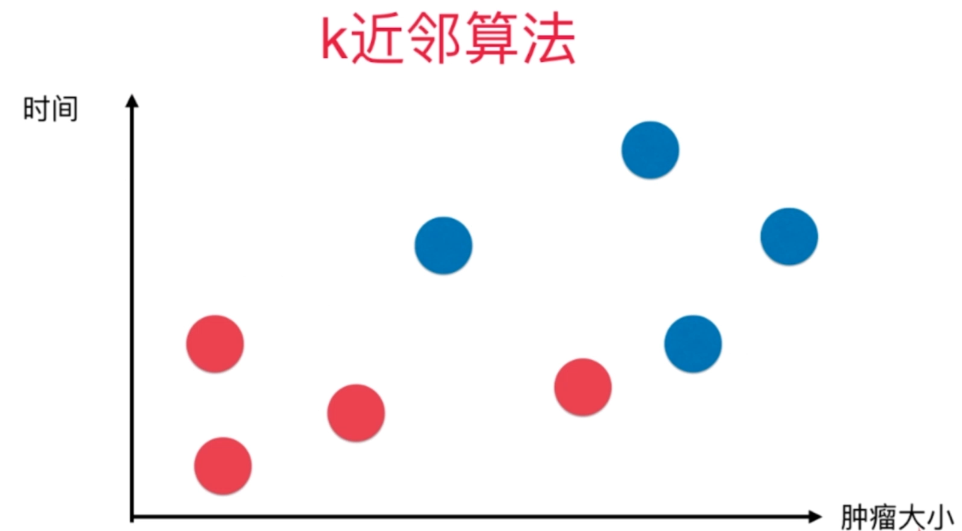

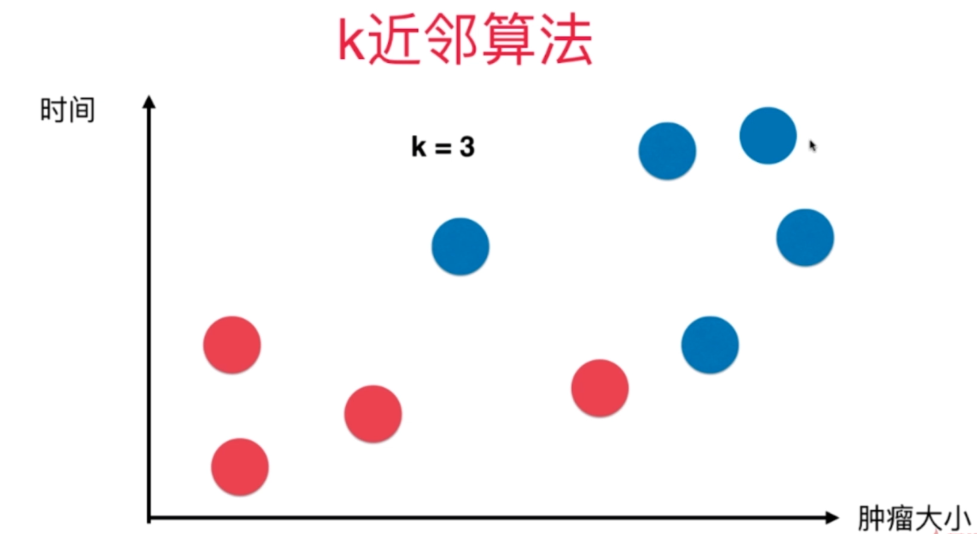
创建简单测试用例
import numpy as np
import matplotlib.pyplot as plt
raw_data_X = [[3.393533211, 2.331273381],
[3.110073483, 1.781539638],
[1.343808831, 3.368360954],
[3.582294042, 4.679179110],
[2.280362439, 2.866990263],
[7.423436942, 4.696522875],
[5.745051997, 3.533989803],
[9.172168622, 2.511101045],
[7.792783481, 3.424088941],
[7.939820817, 0.791637231]
]
raw_data_y = [0, 0, 0, 0, 0, 1, 1, 1, 1, 1]
X_train = np.array(raw_data_X)
y_train = np.array(raw_data_y)
plt.scatter(X_train[y_train==0,0], X_train[y_train==0,1], color='g')
plt.scatter(X_train[y_train==1,0], X_train[y_train==1,1], color='r')
plt.show()

预测
x = np.array([8.093607318, 3.365731514])
plt.scatter(X_train[y_train==0,0], X_train[y_train==0,1], color='g')
plt.scatter(X_train[y_train==1,0], X_train[y_train==1,1], color='r')
plt.scatter(x[0], x[1], color='b')
plt.show()
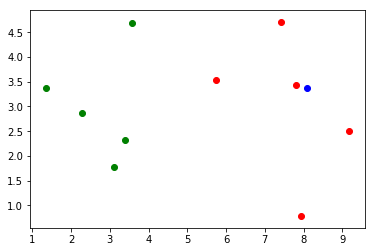
KNN过程
from math import sqrt
distances = []
for x_train in X_train:
d = sqrt(np.sum((x_train - x)**2))
distances.append(d)
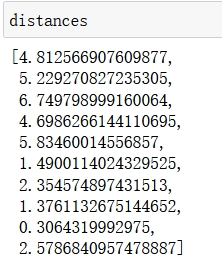
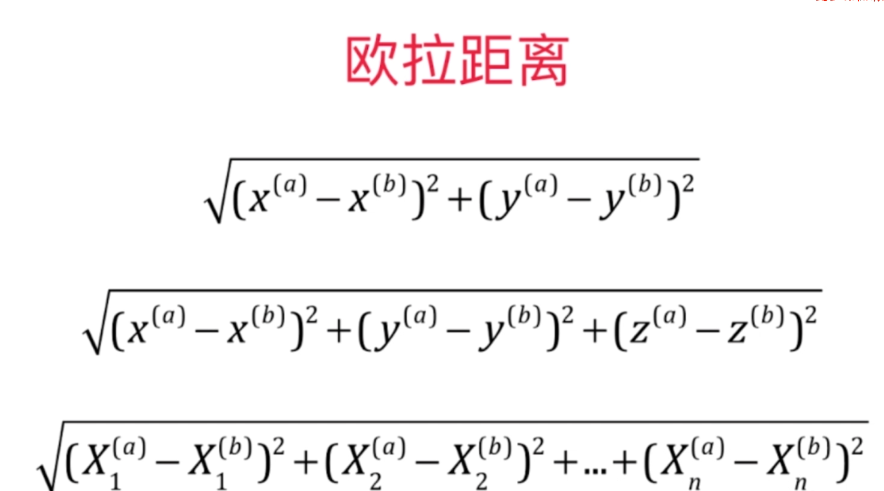
distances = [sqrt(np.sum((x_train - x)**2))
for x_train in X_train]
数组排序返回索引
np.argsort(distances)
nearest = np.argsort(distances)
最近k个点相近的y坐标
k = 6
topK_y = [y_train[neighbor] for neighbor in nearest[:k]]
topK_y

统计
from collections import Counter
votes = Counter(topK_y)
votes.most_common(1)
predict_y = votes.most_common(1)[0][0]
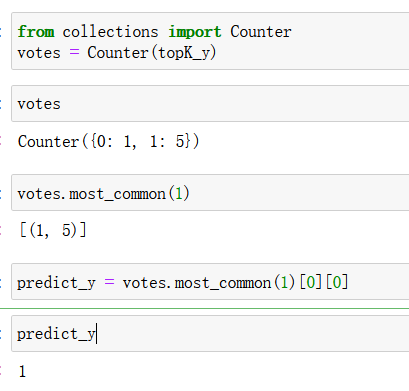
封装
import numpy as np
from math import sqrt
from collections import Counter
def kNN_classify(k, X_train, y_train, x):
assert 1 <= k <= X_train.shape[0], "k must be valid"
assert X_train.shape[0] == y_train.shape[0], \
"the size of X_train must equal to the size of y_train"
assert X_train.shape[1] == x.shape[0], \
"the feature number of x must be equal to X_train"
distances = [sqrt(np.sum((x_train - x)**2)) for x_train in X_train]
nearest = np.argsort(distances)
topK_y = [y_train[i] for i in nearest[:k]]
votes = Counter(topK_y)
return votes.most_common(1)[0][0]
- k近邻算法是非常特殊的,可以被认为是没有模型的算法
- 为了和其他算法统一,可以认为训练数据集就是模型本身
使用scikit-learn中的kNN
raw_data_X = [[3.393533211, 2.331273381],
[3.110073483, 1.781539638],
[1.343808831, 3.368360954],
[3.582294042, 4.679179110],
[2.280362439, 2.866990263],
[7.423436942, 4.696522875],
[5.745051997, 3.533989803],
[9.172168622, 2.511101045],
[7.792783481, 3.424088941],
[7.939820817, 0.791637231]
]
raw_data_y = [0, 0, 0, 0, 0, 1, 1, 1, 1, 1]
X_train = np.array(raw_data_X)
y_train = np.array(raw_data_y)
x = np.array([8.093607318, 3.365731514])
from sklearn.neighbors import KNeighborsClassifier
kNN_classifier = KNeighborsClassifier(n_neighbors=6)
kNN_classifier.fit(X_train, y_train)
#预测
kNN_classifier.predict(x)
#转化为矩阵
X_predict = x.reshape(1, -1)
kNN_classifier.predict(X_predict)
y_predict = kNN_classifier.predict(X_predict)
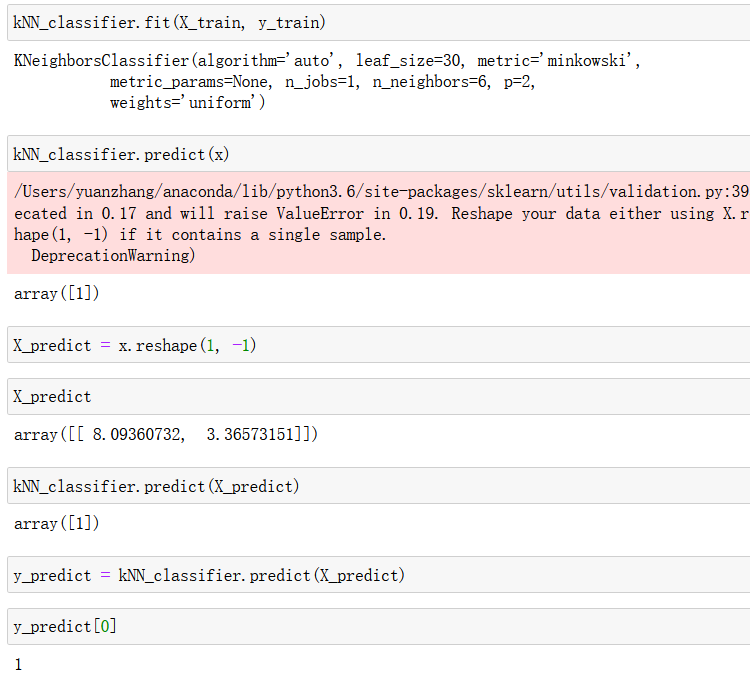
优化封装的KNN
import numpy as np
from math import sqrt
from collections import Counter
class KNNClassifier:
def __init__(self, k):
"""初始化kNN分类器"""
assert k >= 1, "k must be valid"
self.k = k
self._X_train = None
self._y_train = None
def fit(self, X_train, y_train):
"""根据训练数据集X_train和y_train训练kNN分类器"""
assert X_train.shape[0] == y_train.shape[0], \
"the size of X_train must be equal to the size of y_train"
assert self.k <= X_train.shape[0], \
"the size of X_train must be at least k."
self._X_train = X_train
self._y_train = y_train
return self
def predict(self, X_predict):
"""给定待预测数据集X_predict,返回表示X_predict的结果向量"""
assert self._X_train is not None and self._y_train is not None, \
"must fit before predict!"
assert X_predict.shape[1] == self._X_train.shape[1], \
"the feature number of X_predict must be equal to X_train"
y_predict = [self._predict(x) for x in X_predict]
return np.array(y_predict)
def _predict(self, x):
"""给定单个待预测数据x,返回x的预测结果值"""
assert x.shape[0] == self._X_train.shape[1], \
"the feature number of x must be equal to X_train"
distances = [sqrt(np.sum((x_train - x) ** 2))
for x_train in self._X_train]
nearest = np.argsort(distances)
topK_y = [self._y_train[i] for i in nearest[:self.k]]
votes = Counter(topK_y)
return votes.most_common(1)[0][0]
def __repr__(self):
return "KNN(k=%d)" % self.k
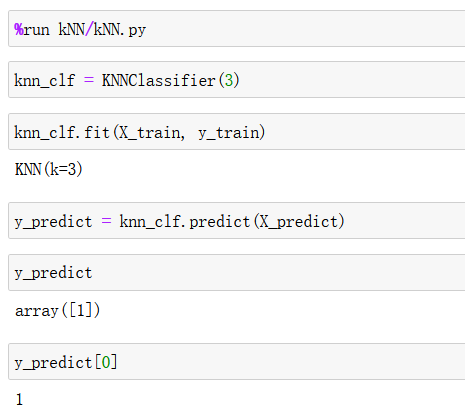
判断机器学习算法的性能-训练数据分割测试数据
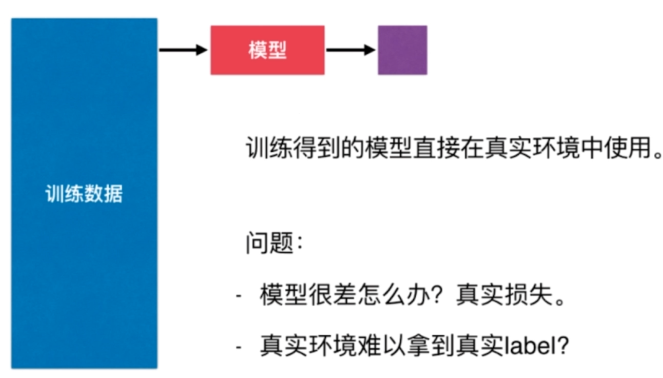
分一部分数据设置为测试数据
 、
、
train test split
加载数据
import numpy as np
import matplotlib.pyplot as plt
from sklearn import datasets
iris = datasets.load_iris()
iris.keys()
X = iris.data
y = iris.target
X.shape
y.shape
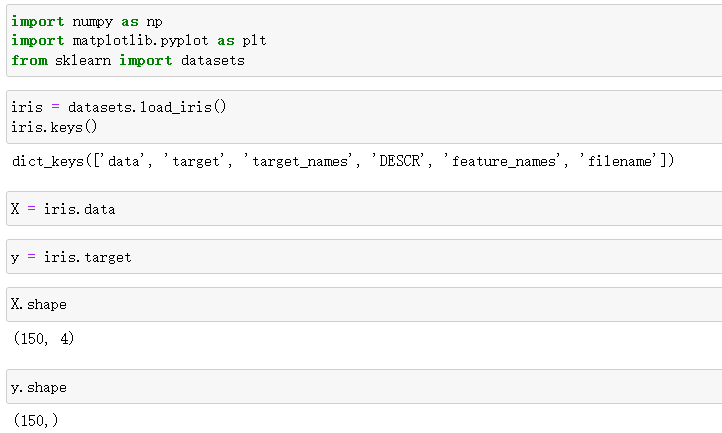
**分离出一部分数据做训练,另外一部分数据做测试 **
将索引随机排列
shuffled_indexes = np.random.permutation(len(X))
shuffled_indexes
设置测试数据百分比
获取测试数据
test_ratio = 0.2
test_size = int(len(X) * test_ratio)
test_indexes = shuffled_indexes[:test_size]
train_indexes = shuffled_indexes[test_size:]
X_train = X[train_indexes]
y_train = y[train_indexes]
X_test = X[test_indexes]
y_test = y[test_indexes]

封装算法
import numpy as np
def train_test_split(X, y, test_ratio=0.2, seed=None):
"""将数据 X 和 y 按照test_ratio分割成X_train, X_test, y_train, y_test"""
assert X.shape[0] == y.shape[0], \
"the size of X must be equal to the size of y"
assert 0.0 <= test_ratio <= 1.0, \
"test_ration must be valid"
if seed:
np.random.seed(seed)
shuffled_indexes = np.random.permutation(len(X))
test_size = int(len(X) * test_ratio)
test_indexes = shuffled_indexes[:test_size]
train_indexes = shuffled_indexes[test_size:]
X_train = X[train_indexes]
y_train = y[train_indexes]
X_test = X[test_indexes]
y_test = y[test_indexes]
return X_train, X_test, y_train, y_test

sklearn中的train_test_split
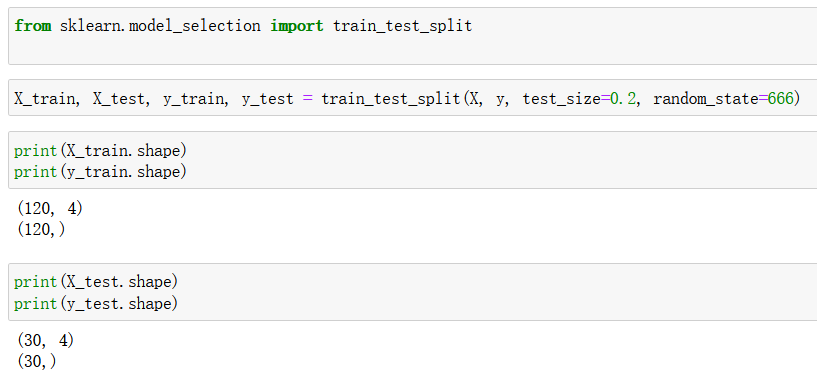
分类准确度
加载手写数字数据
import numpy as np
import matplotlib.pyplot as plt
from sklearn import datasets
digits = datasets.load_digits()
digits.keys()
X = digits.data
X.shape
y = digits.target
y.shape

查看数据
some_digit = X[666]
some_digit_image = some_digit.reshape(8, 8)
import matplotlib
import matplotlib.pyplot as plt
plt.imshow(some_digit_image, cmap = matplotlib.cm.binary)
plt.show()

预测准确率
from playML.model_selection import train_test_split
X_train, X_test, y_train, y_test = train_test_split(X, y, test_ratio=0.2)
from playML.kNN import KNNClassifier
my_knn_clf = KNNClassifier(k=3)
my_knn_clf.fit(X_train, y_train)
y_predict = my_knn_clf.predict(X_test)
sum(y_predict == y_test) / len(y_test)
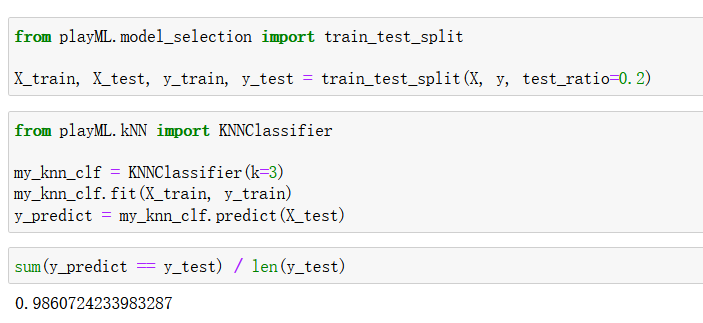
封装自己的accuracy_score
import numpy as np
def accuracy_score(y_true, y_predict):
'''计算y_true和y_predict之间的准确率'''
assert y_true.shape[0] == y_predict.shape[0], \
"the size of y_true must be equal to the size of y_predict"
return sum(y_true == y_predict) / len(y_true)
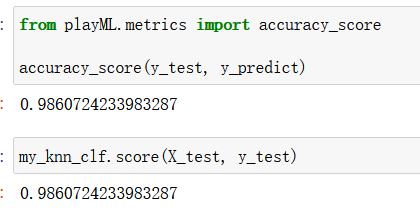
scikit-learn中的accuracy_score
from sklearn.model_selection import train_test_split
X_train, X_test, y_train, y_test = train_test_split(X, y, test_size=0.2, random_state=666)
from sklearn.neighbors import KNeighborsClassifier
knn_clf = KNeighborsClassifier(n_neighbors=3)
knn_clf.fit(X_train, y_train)
y_predict = knn_clf.predict(X_test)
from sklearn.metrics import accuracy_score
accuracy_score(y_test, y_predict)
超参数和模型参数
- 超参数:在算法运行前需要决定的参数
- 模型参数:算法过程中学习的参数
KNN算法没有模型参数
KNN算法中的K是典型的超参数
寻找好的超参数
- 领域知识
- 经验数值
- 实验搜索
加载手写数字数据集
import numpy as np
from sklearn import datasets
digits = datasets.load_digits()
X = digits.data
y = digits.target
from sklearn.model_selection import train_test_split
X_train, X_test, y_train, y_test = train_test_split(X, y, test_size=0.2, random_state=666)
from sklearn.neighbors import KNeighborsClassifier
knn_clf = KNeighborsClassifier(n_neighbors=3)
knn_clf.fit(X_train, y_train)
knn_clf.score(X_test, y_test)
寻找最好的k、
best_score = 0.0
best_k = -1
for k in range(1, 11):
knn_clf = KNeighborsClassifier(n_neighbors=k)
knn_clf.fit(X_train, y_train)
score = knn_clf.score(X_test, y_test)
if score > best_score:
best_k = k
best_score = score
print("best_k =", best_k)
print("best_score =", best_score)
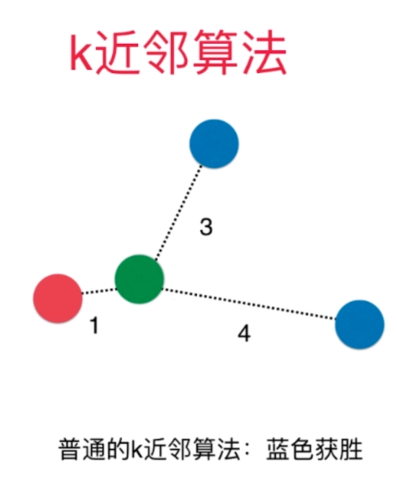

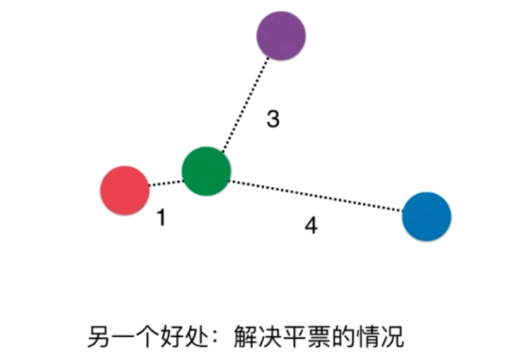
加入是否考虑距离
best_score = 0.0
best_k = -1
best_method = ""
for method in ["uniform", "distance"]:
for k in range(1, 11):
knn_clf = KNeighborsClassifier(n_neighbors=k, weights=method)
knn_clf.fit(X_train, y_train)
score = knn_clf.score(X_test, y_test)
if score > best_score:
best_k = k
best_score = score
best_method = method
print("best_method =", best_method)
print("best_k =", best_k)
print("best_score =", best_score)
明可夫斯基距离

best_score = 0.0
best_k = -1
best_p = -1
for k in range(1, 11):
for p in range(1, 6):
knn_clf = KNeighborsClassifier(n_neighbors=k, weights="distance", p=p)
knn_clf.fit(X_train, y_train)
score = knn_clf.score(X_test, y_test)
if score > best_score:
best_k = k
best_p = p
best_score = score
print("best_k =", best_k)
print("best_p =", best_p)
print("best_score =", best_score)
网格搜索 Grid Search
定义搜索参数
param_grid = [
{
'weights': ['uniform'],
'n_neighbors': [i for i in range(1, 11)]
},
{
'weights': ['distance'],
'n_neighbors': [i for i in range(1, 11)],
'p': [i for i in range(1, 6)]
}
]
knn_clf = KNeighborsClassifier()
from sklearn.model_selection import GridSearchCV
grid_search = GridSearchCV(knn_clf, param_grid)
grid_search.fit(X_train, y_train)
查看最佳分类器参数和准确度
grid_search.best_estimator_
grid_search.best_score_

更多的距离定义
- 向量空间余弦相似度 Cosine Similarity
- 调整余弦相似度 Adjusted Cosine Similarity
- 皮尔森相关系数 Pearson Correlation Coefficient
- Jaccard相似吸收 Jaccard Coeffcient
数据归一化 Feature Scaling
将所有的数据映射到同一尺度
最值归一化 normalization:把所有数据映射到0-1之间
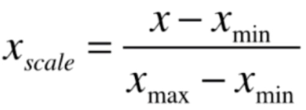
适用于分布有明显边界的情况;受outlier影响较大
x = np.random.randint(0, 100, 100)
(x - np.min(x)) / (np.max(x) - np.min(x))
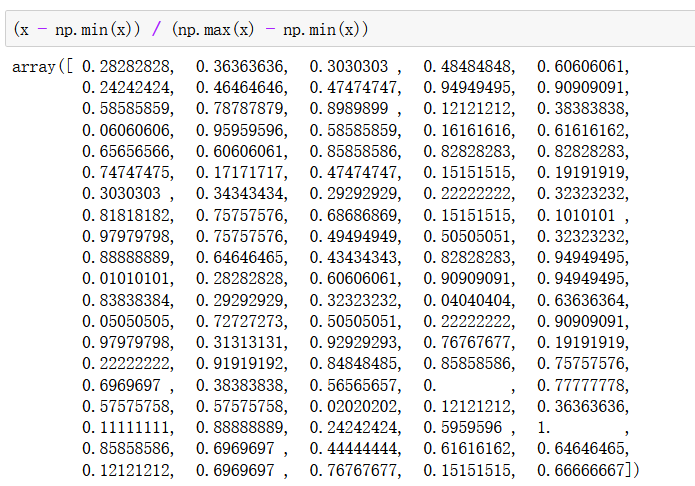
X = np.random.randint(0, 100, (50, 2))
X = np.array(X, dtype=float)
X[:,0] = (X[:,0] - np.min(X[:,0])) / (np.max(X[:,0]) - np.min(X[:,0]))
X[:,1] = (X[:,1] - np.min(X[:,1])) / (np.max(X[:,1]) - np.min(X[:,1]))
X[:10,:]
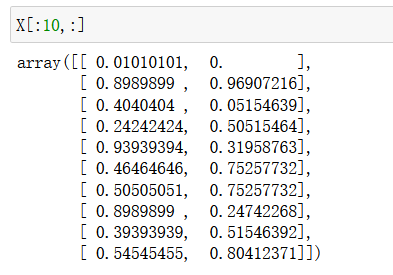
均值方差归一化 standardization
数据分布没有明显的边界,有可能存在极端数据值
均值方差归一化:把所有数据归一到均值为0方差为1的分布中
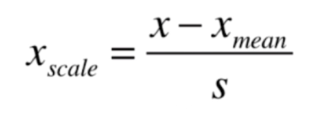
X2 = np.random.randint(0, 100, (50, 2))
X2 = np.array(X2, dtype=float)
X2[:,0] = (X2[:,0] - np.mean(X2[:,0])) / np.std(X2[:,0])
X2[:,1] = (X2[:,1] - np.mean(X2[:,1])) / np.std(X2[:,1])
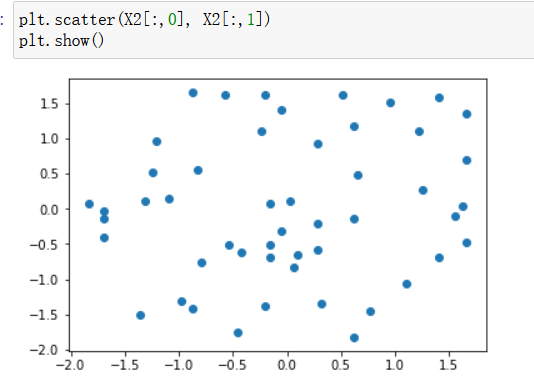
测试数据集的归一化
测试数据说模拟真实环境
- 真实环境很有可能无法得到所有测试数据的均值和方差
- 对数据的归一化也是算法的一部分
(x_test-mean_train)/std_train
scikit-learn中的Scaler
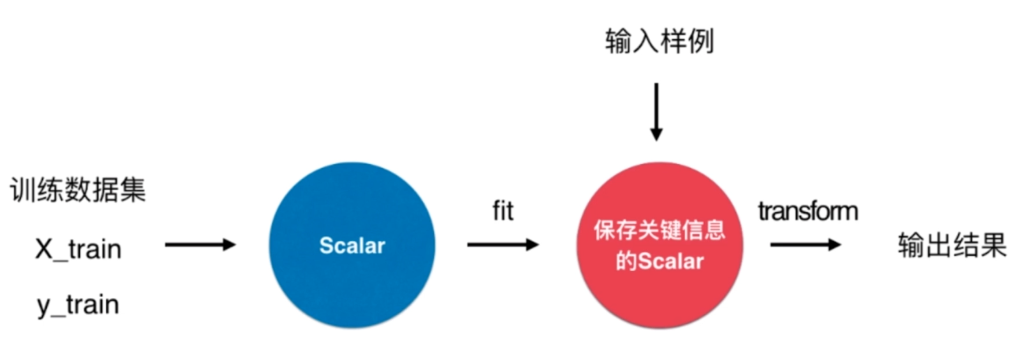
加载数据
import numpy as np
from sklearn import datasets
iris = datasets.load_iris()
X = iris.data
y = iris.target
数据分割
from sklearn.model_selection import train_test_split
X_train, X_test, y_train, y_test = train_test_split(iris.data, iris.target, test_size=0.2, random_state=666)
数据归一化
from sklearn.preprocessing import StandardScaler
standardScalar = StandardScaler()
standardScalar.fit(X_train)
standardScalar.transform(X_train)#归一化
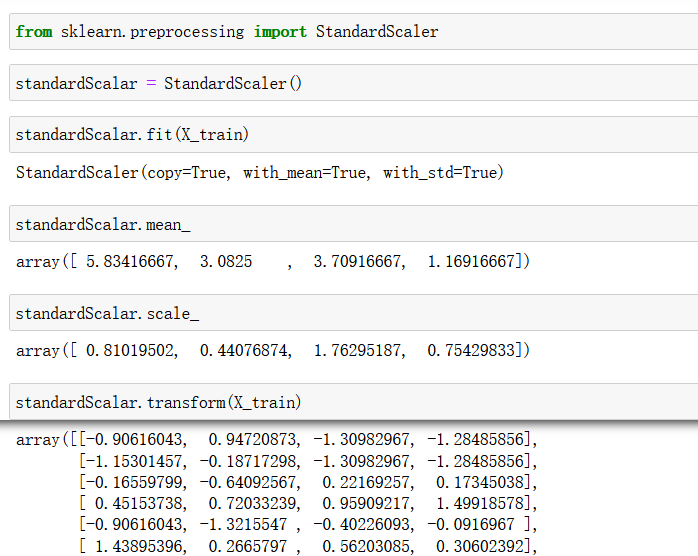
归一化结果赋值
X_train = standardScalar.transform(X_train)
X_test_standard = standardScalar.transform(X_test)
使用归一化后的数据进行knn分类
from sklearn.neighbors import KNeighborsClassifier
knn_clf = KNeighborsClassifier(n_neighbors=3)
knn_clf.fit(X_train, y_train)
knn_clf.score(X_test_standard, y_test)
实现自己的standardScaler
import numpy as np
class StandardScaler:
def __init__(self):
self.mean_ = None
self.scale_ = None
def fit(self, X):
"""根据训练数据集X获得数据的均值和方差"""
assert X.ndim == 2, "The dimension of X must be 2"
self.mean_ = np.array([np.mean(X[:,i]) for i in range(X.shape[1])])
self.scale_ = np.array([np.std(X[:,i]) for i in range(X.shape[1])])
return self
def transform(self, X):
"""将X根据这个StandardScaler进行均值方差归一化处理"""
assert X.ndim == 2, "The dimension of X must be 2"
assert self.mean_ is not None and self.scale_ is not None, \
"must fit before transform!"
assert X.shape[1] == len(self.mean_), \
"the feature number of X must be equal to mean_ and std_"
resX = np.empty(shape=X.shape, dtype=float)
for col in range(X.shape[1]):
resX[:,col] = (X[:,col] - self.mean_[col]) / self.scale_[col]
return resX
有关k近邻算法
解决分类问题
天然可以解决多分类问题
思想简单,效果强大
最大缺点:效率低下
如果训练集有m个样本,n个特征,则预测每一个新的数据,需要O(m*n)
优化 使用树结构:KD-Tree,Ball-Tree
缺点2:高度数据相关
缺点3:预测结果不具有可解释性
维数灾难
随着维度的增加,“看似相近”的两个点之间的距离越来越大
解决方法:降维、

